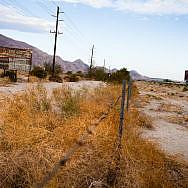Salton City landfill grows to 40 times its original size with trash from all over SoCal
The landfill in Salton City will go from being an 8-acre municipal site, to a 320-acre private one. But contamination from trash juice isn't the real concern: it's the threat of increased diesel truck traffic. There is a long-running scientific link between traffic air pollution and health problems.
Ruxandra Guidi reported these stories for Southern California Public Radio as a 2012 California Endowment Health Journalism Fellow. Other stories in this series include:
Illegal trash dumping impacts Eastern Coachella Valley residents

Burrtec, a waste management company based in San Bernardino, bought the old landfill site in Salton City, CA from Imperial County in 2008.
State Route 86 starts just north of the Mexican border, traveling through the Imperial Valley cities of El Centro, Brawley, and along the Salton Sea. The four-lane road sees a great deal of round-the-clock 18-wheeler traffic coming from Mexicali, and from nearby agricultural fields, making it a notoriously dangerous route. It’s even been dubbed “Blood Alley,” because of so many car accidents.
Trucks carrying trash will be coming from hundreds of miles away--from San Bernardino, San Diego, Los Angeles. The local landfill, which had taken in trash from a population of 4,000 people, will go from being an 8-acre municipal site, to a 320-acre private one.
Five years ago, Steven Bolettieri and his wife retired in Salton City because house prices were cheap. Now, he’s concerned that plans to expand the municipal landfill will make his home worth even less—and will bring more air pollution, from 300 more trucks daily, to boot.
“When you talk about these diesel trucks, they’re going to be barreling down Route 86," says Bolettieri. "They’re going be doing 55 to 60 miles an hour, easily. I don’t appreciate these trucks being increased to just bring other people’s trash here. I didn’t move here so other people’s trash could be moved here for me.”
Here’s how it happened: In 2008 Imperial County found itself with an old landfill that wasn’t meeting environmental standards. It lacked a special liner that would prevent leachate, the trash juice that seeps into the soil and contaminates surface and groundwater.
So the county asked waste management companies to put in bids for an expansion. The County Board of Supervisors held no public hearings, and the contract for a huge landfill—40 times the original size—went to Burrtec, a waste management company based in San Bernardino County.
Since finding out about the deal, the Bolettieris have been meeting with neighbors, including Lynda Lou True, to look through environmental reviews of the landfill.
“We really don’t want this in our area," says True, flipping through the pages of a county document. "We know from history that if you pile up garbage, it becomes poisonous, it leaches into the water systems, it endangers human and wildlife. It just does.”
While it is true that leachate can be very harmful to public health, stricter Environmental Protection Agency guidelines from the past ten years have made this kind of pollution less likely.
“Landfill facilities are extremely regulated in California, multiple agencies are looking at them," says Lars Seifert, the environmental health services manager for Imperial County "They are doing inspections, monitoring landfill gas, groundwater. There is a lot of stuff that goes into landfill design and operation.” Seifert says his agency closely monitors both public and private landfills.
But in the case of Salton City, contamination from trash juice isn't the real concern: it's the threat of increased diesel truck traffic. There is a long-running scientific link between traffic air pollution and health problems.
If all goes according to plan, the Salton City landfill’s expansion will start soon. Burrtec has so far paid $2 million to secure the site from Imperial County, and depending on how much waste it can bring from far away places, it will pay the county $3 million more.
This story was originally published on Southern California Public Radio.

